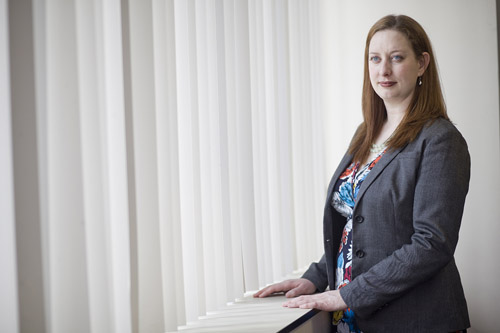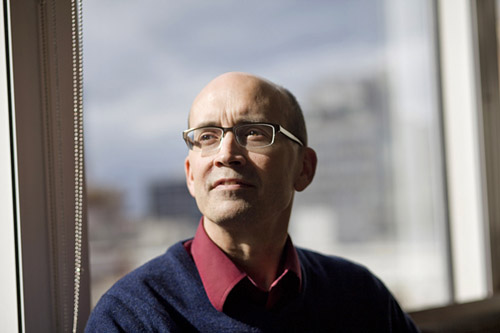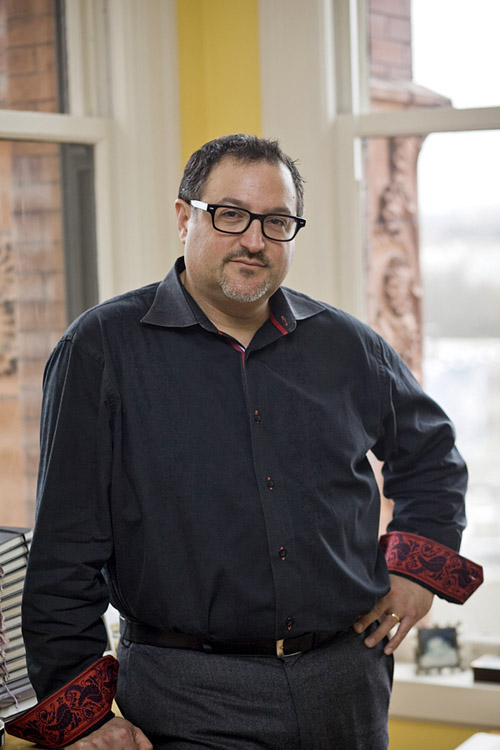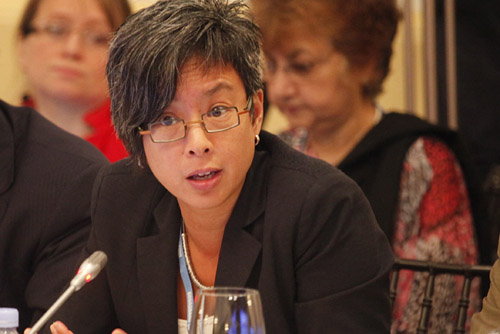BY LINDA BAKER
New business models blur the line between for-profits and nonprofits.
BY LINDA BAKER | PHOTOS BY CARL KIILSGAARD*
*CHANG PHOTOS COURTESY MERCY CORPS
I. In the beginning, there were clear boundaries between the world of business and the world of nonprofits. The former revolved around financial targets like sales growth and investor returns — the latter aimed for collaboration and the social good. Then the world flattened; the economy collapsed, Internet technologies democratized entrepreneurship, and mounting anxiety about environmental degradation prompted businesses of all stripes to green their marketing, products and services.
These shifts — some might call them seismic — set the stage for the emergence of what insiders are calling “the fourth sector” of the economy: hybrid organizations that are neither government agency, for-profit or nonprofit but contain elements of all three. The idea, and it’s still very much an idea, didn’t spring up overnight but instead grew out of several decades of change in which for-profits tried to become more socially conscious and nonprofits more market oriented, the latter often adding revenue-generating programs to supplement declining government funding.
So far the fourth sector is more theory than practice, more embryonic than fully formed, but the concept itself is yet another example of 21st-century innovation. At least on the for-profit side, it’s less about tacking a social mission onto business than an attempt to rethink the deep structure of business itself. Much as the sharing economy is less about a new product or service than a rethinking of the ownership economy, the fourth sector aims to create an entirely new model for simultaneously making money and effecting positive social change.
Skeptics might claim the idea is too good to be true, and that a hybrid model will only dilute profits while opening up new opportunities for green washing and other forms of exploitation — of consumers, the disadvantaged and the tax code. Potential drawbacks notwithstanding, one thing is clear: In Oregon a new generation of leaders is hot on the trail, launching an array of fourth-sector initiatives and projects. Impact funds, benefit corporations and social enterprise are among the jargon phrases that capture the various manifestations of their work.
Oregon Business caught up with a few of the key players in this “blended capital” space. Their goals are ambitious: to enlarge the boundaries of capitalism itself, marrying the financial returns generated by the market with the selflessness and community orientation typically linked to the nonprofit enterprise.
II. The social venture capitalist
 Carolynn Duncan started her career as a social worker, serving at-risk teens in the nonprofit and government sectors. She soon became overwhelmed by the scope of the problems she encountered. “I thought: ‘I can help 10 kids at a time and it will do absolutely nothing because there are millions of kids with these issues.’” So Duncan’s career took a sharp left turn; she started working in business development and venture capital, sourcing deals for Epic Ventures, a Salt Lake City-based firm, developed an entrepreneurial finance program and ran LivePitch events for FundingUniverse (now Lendio).
Carolynn Duncan started her career as a social worker, serving at-risk teens in the nonprofit and government sectors. She soon became overwhelmed by the scope of the problems she encountered. “I thought: ‘I can help 10 kids at a time and it will do absolutely nothing because there are millions of kids with these issues.’” So Duncan’s career took a sharp left turn; she started working in business development and venture capital, sourcing deals for Epic Ventures, a Salt Lake City-based firm, developed an entrepreneurial finance program and ran LivePitch events for FundingUniverse (now Lendio).
“It was awesome — all about scale and how do you grow from zero to $100 million in five years,” she says. “To do that, you have to have a level of discipline. But then I was like, ‘I’m going to become an asshole,’ and that’s not what I wanted either.”
Today Duncan is the CEO of TenX, a for-profit business accelerator that runs financial literacy programs for entrepreneurs and business leaders. She is also the founding partner of the Northwest Social Venture Fund, a $20 million fund that invests in technology startups with a social mission and less than $1 million in revenue. The fund itself is owned by a nonprofit foundation, the Northwest Social Venture Foundation.
These three entities fall at different points along the blended capital spectrum, Duncan notes. But they share a single objective: “to alleviate suffering in the world through scalable social entrepreneurship and impact investing.” Impact investing, investments that seek to deliver positive social or environmental change (impact), has been in play for over a decade; what distinguishes the Social Venture Fund is the focus on high-risk, early-stage startups that could be acquired or go public.
“Like any other venture fund, we look for something that can scale and can provide investment-level returns. But differently than other venture funds, we invest exclusively in impact companies. There has to be a core humanitarian thing in the world that is being solved because of what they’re doing.”
The fund recently selected its first two investments: InStove, a Cottage Grove company that manufactures biomass cookstoves for developing countries, and Seattle-based Litesprite, a gaming platform that helps people manage anxiety and depression.
Both the Social Venture Foundation and TenX — an entity that co-hosts the Social Venture Society’s Hacking Social Impact “unconference” — embody similar blended principles. The business accelerator has volunteers; most for-profits do not. Meanwhile, the fund is housed under the foundation, a bureaucratic decision that “makes us put our money where our mouth is,” explains Duncan. Foundations are legally required to distribute a certain percentage of investment assets each year to charity.
“We’re not branding ourselves as impact for purpose of attracting a different set of investors who like us more because they are philanthropically minded. We have operating contingencies to do certain things with our capital.”
Merging corporate and philanthropic structures and staff involves a bit of a learning curve, Duncan acknowledges. “It’s a bilingual problem. A business calls personnel their ‘team’; nonprofits call it ‘staff.’ It’s the exact same thing. Nonprofits talk about ‘earned income.’” For profits call it ‘revenue’ — same thing.”
“What I hope will happen is there will be formalization around a hybrid entity in which you blend the best practices of both, people speak both languages and there are legal structures that house you as both.”
III. Redefining business
Portlanders who shop at New Seasons have probably noticed the B Corp logo (a circumscribed B) stamped on the grocer’s shopping bags — and employee buttons. Indeed, in Oregon, the B Corp logo is cropping up everywhere: in the offices of remodeling firm Neil Kelly, the investment firm Equilibrium Capital and Eugene-based Good Clean Love, which sells sexual health products.
But what is a B Corp exactly? Since 2007, a Pennsylvania nonprofit called B Lab has been certifying for-profit companies that demonstrate sustainable business practices, such as reducing energy and water use and employee profit-sharing. Certified B Corps must also change their articles of corporation to take into consideration the environmental and social impacts of business decisions.
By contrast, the traditional corporation (C Corp) has a single mandate: maximizing profit for shareholders. Changing the company’s legal structure is one of the key differences between B Corp and other green-business certifications; the idea is B Corp status offers more flexibility for businesses that might otherwise be required to focus on the demands of shareholders.
In Oregon there are two pathways to becoming a B Corp. Businesses can pursue certification through B Lab — a process that requires meeting social, environmental and accountability standards. Companies can also register as benefit corporations under a state law passed in January. As of mid-April, there were 46 certified B Corps and 52 benefit corporations in Oregon, with 12 companies qualifying as both.
The B Corp files
Pioneer banker
 This past January, a quiet revolution took place in Oregon’s banking community. Following unanimous approval by its board, Portland-based Capital Pacific Bank became one of only two publicly traded banks and one of six public companies in the country to achieve certified B Corp status.
This past January, a quiet revolution took place in Oregon’s banking community. Following unanimous approval by its board, Portland-based Capital Pacific Bank became one of only two publicly traded banks and one of six public companies in the country to achieve certified B Corp status.
The key to convincing the board was emphasizing the value of certification to shareholders, says CEO Mark Stevenson, who comes across as at once mild mannered and intensely passionate about the cause. “I have two institutional board members and two who are business owners,” he says. “If this had been a plan to make less money, it would not fly.”
Stevenson says months of investigation — including attending the annual SRI Conference on Sustainable, Responsible, Impact Investing in Colorado — convinced him that B Corp certification would not only yield stronger shareholder returns, it would actually strengthen the bank’s financial standing. Capital Pacific could use more liquidity, Stevenson says. “The question is what can you do to expand interest in your stock? B Corp allows you to have a conversation with people you would otherwise not have access to.”
Although the number of registered B Corp businesses continues to grow — more than 900 companies have become certified worldwide — the B Corp movement is largely a private-company phenomenon. Bringing publicly traded firms onboard is no easy task; at the very least, explaining the complexities of the B Corp process to shareholders is a huge logistics problem. “How do you do that in a proxy statement?” Stevenson asks.
But as time goes on, more public companies will make the switch, he believes. And even as he plugs the financial benefits, Stevenson can’t help but describe the intangible rewards. Capital Pacific employees led the push for B Corp certification; when their boss delivered the good news regarding the board vote, a cheer reverberated around the office. “How is that not great for shareholders?” Stevenson says. “I’ve got an engaged staff. That’s gold — even if you’re a money manager.”
 Eric Friedenwald-Fishman
Eric Friedenwald-Fishman
Founder and creative director, Metropolitan Group
The benefits: “We have received some marketing impact but that’s not why we became a B Corp. The benefit is we now have a comprehensive assessment tool, a set of best practices measuring us against other firms, and we use that to drive our thinking. We just went through reassessment and made some adjustments to our purchasing policies, travel policies that have been good for the environment and save budget.”
The big picture: “There is an expectation that business is going to move to a place that provides a blended benefit to shareholders and all other stakeholders. There are hard-core economic realities, increasing shortages of water, energy, that are going to drive that shift. It’s not about being a good person. The market has moved to a place where companies that are looking at ways of monetizing solutions to key societal problems are considered companies that are good to invest in.”
Justin Yuen
Founder and president, FMYI (For My Innovation)
The benefits: “B Corp is a great mechanism for pushing corporate social responsibility to more companies that may not have the resources of a Nike. For us, the real benefit was the presence of a defined assessment giving us a score ranking our practices on the triple-bottom-line front.”
The limits: “For large companies, a barrier to becoming a B Corp is that change to their articles of incorporation. There may come a day when institutional investors are interested in that.”
The big picture: “Our generation of B Corp tech companies is not driven by tax benefits but livability to help retain and recruit workers.”
Next: “B Corp is a start for the conversation, and I’m keen on seeing this grow as a movement. But the most exciting CSR pieces are social enterprises that solve a community or environmental problem but generate a profit doing so. In terms of scaling some of the solutions to these problems, businesses can play a unique role.”
IV. Silicon Valley humanitarians
Why do investors shy away from mission-driven businesses in the developing world? Ann Mei Chang doesn’t mince words. “You’re working in challenging environments with poor people,” she says. “It’s not a great equation for people who want to invest.”
 A former senior engineering director at Google, Chang now holds the title of chief innovation officer at Mercy Corps, the well-regarded, Portland-based aid organization. Mercy Corps has a long history of working on what Chang refers to as “scalable” social ventures — such as microfinance operations that loan small amounts of money to people in poverty. Now Chang aims to bring her “business expertise, a crisper focus and more rigorous methodology” to these efforts.
A former senior engineering director at Google, Chang now holds the title of chief innovation officer at Mercy Corps, the well-regarded, Portland-based aid organization. Mercy Corps has a long history of working on what Chang refers to as “scalable” social ventures — such as microfinance operations that loan small amounts of money to people in poverty. Now Chang aims to bring her “business expertise, a crisper focus and more rigorous methodology” to these efforts.
Getting investors onboard is part of that project. Enter the Mercy Corps Venture Fund, a Chang-led initiative aimed at attracting early-stage funding to social ventures in the developing world. The fund is seeking a $10 million raise, with about a dozen projects currently under review. “The focus is about creating a business model that can be self-sustainable,” says Chang. “We want to be very rigorous about the projects that look most promising. Only after we prove the model can work can we look at investors.”
One possible candidate is MiCRO, a natural-catastrophe microinsurance startup Mercy Corps launched, along with a local microfinance institution, Fonkoze, and the global reinsurer Swiss Re. Following a pilot project in Haiti, the company plans to add hundreds of thousands of clients over the next five years, emerging with the first global- insurance product that can mitigate natural-disaster losses faced by the poor in Africa, Asia and Latin America.
 The Mercy Corps Venture Fund capitalizes on two simultaneous trends: On the nonprofit side, there is growing concern about the limitations of the traditional grant model, in which aid programs receive large amounts of money but often serve a limited number of people. Meanwhile, a new crop of investors, especially in the tech sector, are looking for outside challenges and opportunities. Silicon Valley executives have amassed enormous fortunes, Chang observes. “They are starting to say, ‘I have more money than I need; how can I make the world a better place?’”
The Mercy Corps Venture Fund capitalizes on two simultaneous trends: On the nonprofit side, there is growing concern about the limitations of the traditional grant model, in which aid programs receive large amounts of money but often serve a limited number of people. Meanwhile, a new crop of investors, especially in the tech sector, are looking for outside challenges and opportunities. Silicon Valley executives have amassed enormous fortunes, Chang observes. “They are starting to say, ‘I have more money than I need; how can I make the world a better place?’”
In recent years, tech leaders have taken a more aggressive stance on a range of public-policy issues, including immigration reform and government surveillance; in April, executives from Apple, Google and others collectively announced their opposition to the Keystone XL Pipeline. Silicon Valley entrepreneurs can be cynical about USAID projects, says Chang. But incubating a small business and taking it global — “that’s a language they understand.” And while Chang acknowledges some services will always require a subsidy — “the public good of having people vaccinated is high enough, you don’t want to rely on people actually paying” — she says other projects, like financial services and urban sanitation, are well suited to a market intervention.
Mercy Corps, which in April announced a new board member, Gisel Kordestani, former director of new business development at Google, is moving more formally into that space. Says Chang: “We want to figure out how to bring the best practices of Silicon Valley to the NGO sector.”
Entrepreneurial foundation
Sayer Jones
Mission investment manager, Meyer Memorial Trust
The problem: “Ninety-five percent of our assets sit in investment accounts, and only five percent are used to do grant work. That five percent doesn’t even come close to what we can do to enhance economic development.”
The solution: In January, the trust launched Invest Oregon, an initiative that will redirect a portion of MMT’s approximately $800 million “corpus” to investment vehicles. So far the fund has invested in the Portland Seed Fund and Ecotrust Forest Management.
The takeaway: “In the past we have focused on nonprofits, but we need to look at social outcomes that come from the for-profit side. There’s a great entrepreneurial environment out there, and we need to start interacting in that space.”
V. Cautionary tales
A key assumption behind impact investing and social ventures is that business and nonprofits can harness the power of the market for social benefit. From the nonprofit perspective, market-oriented initiatives can also help shore up a shaky business model. “The nonprofit model is a very running-by-the-seat-of-your-pants proposition, because it does rely on charitable goodwill toward your mission,” says Jim White, executive director of the Nonprofit Association of Oregon. For years nonprofits have pursued so-called “earned revenue” strategies — setting up affiliated stores or cafes, for example — to help sustain operations, he says. But those efforts can go awry. The recent implosion of Evergreen International Airlines in McMinnville is a case in point. “Things got a little too blended,” White says. At issue was whether the company’s affiliated nonprofit enterprises, including the Evergreen Air and Space museum, deserved its property-tax exemption — especially since the museum’s water park is the star attraction. The Oregon Department of Justice also investigated possible mingling of funds between the for-profit aviation wing and the nonprofit entities, which is prohibited under Oregon law.
The legal restrictions on nonprofits complicate the evolution of blended models. Fueled by new technologies, such models could also pose a new threat to cash-strapped nonprofits. The rise of crowdfunding, for example, allows people to donate to private businesses as if they were a charitable organization. “What’s unique about these kinds of events is there is no return on investment,” White says. Instead, “people are looking at these businesses as a community asset.” He raises an intriguing question: In the future will nonprofits have to compete with social-enterprise startups for donor dollars?
Elements of the nonprofit sector “can’t and shouldn’t be monetized,” White says. “There are people economics leaves behind in our society; that’s the reality.” Looking ahead, he anticipates “confusion and probably court testing” around hybrid organizations. Despite the unknowns, the fourth sector holds powerful promise. As White observes: “It’s a fascinating topic.”


